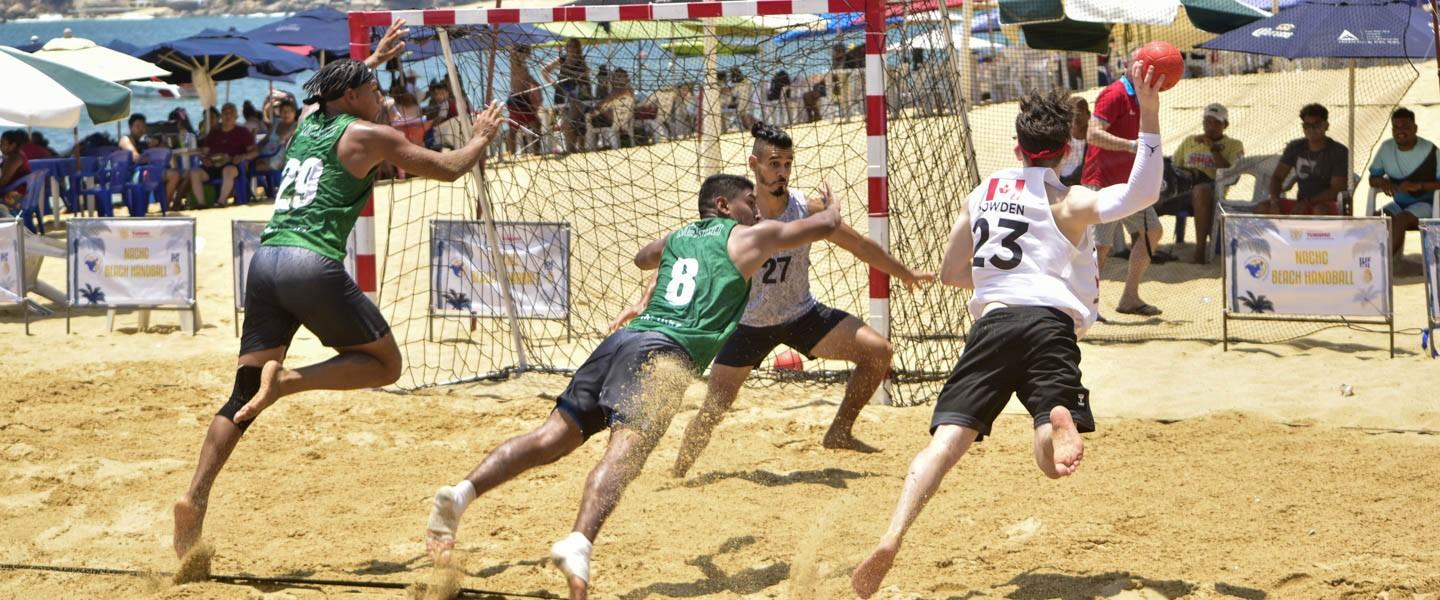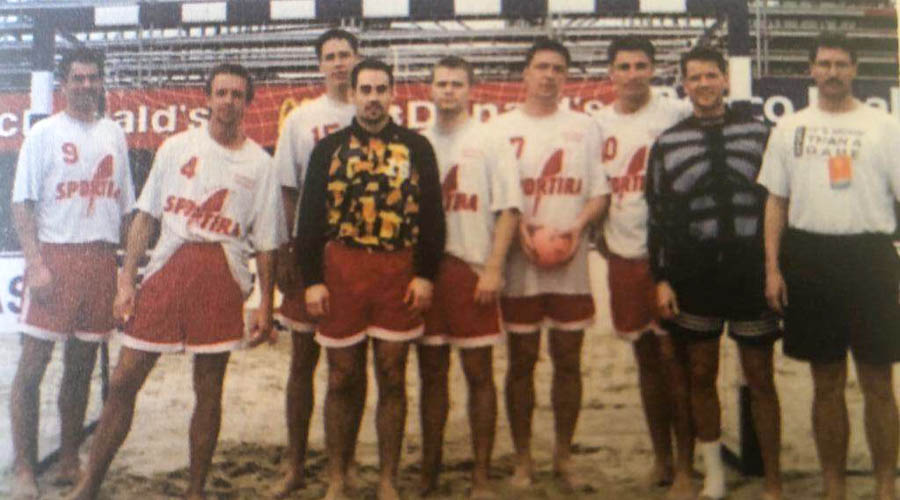News
‘Accelerating down a path’ – beach handball in Canada ready for new heights
13 Apr. 2023

With well over 200,000 km of coastline to its name, Canada has the largest amount anywhere in the world.
And while much of that may not be suitable for beach handball, the North American country has seen a rapid expansion of the sport in recent times.
"Beach handball has started to grow across Canada, mainly in the past five years, and it is approaching the end of a springboard," says Steve Fodor, Head Coach of the Canadian men's beach handball team to ihf.info.
"We are accelerating down a path and with the right technical and financial support, the sport could spring to incredible new heights here."
30 years of history
Beach handball can trace its origins in Canada to the western province of Calgary in the mid-1990s, where it was played recreationally and in mixed men's and women's teams in the summer months. Around the same time, the French forerunner to beach handball, sandball, was played in the province of Manitoba.
It was during this period that Canada formed a men's national team and competed in Brazil in January 1998 after being invited to attend the 'Festival Olímpicos de Verão' (Olympic summer festival) in Rio de Janeiro. The multi-sport event, organised by the Brazilian Olympic Committee, was held on the famous Copacabana Beach with Canada taking on hosts Brazil and a number of other national teams.
With just Calgary and Winnipeg playing beach handball, then the team in Brazil was coached by Gerard Masse and Warren Poncsak and consisted of western Canadian players. Fodor was part of that team alongside fellow indoor players, including Calgary-based Greg Pestka, Edmonton's Mike Ney, Chris Boychuk and Stony Good from Regina and Trevor Knott, Kris Kendall and Robert Monet from Winnipeg.
The North American team were on the continental stage and looking to get a foothold in the sporting market on their return home, but the sport did not push on competitively in Canada, continuing as it had before.
"After Rio, there was not really a national programme plan for the sport," explains Fodor, who shortly after Brazil retired from playing on both the national indoor and beach handball teams at the age of 36.
"Some cities, such as Calgary, continued with a little beach handball, but only at that recreational level and during that period I made the transition from a beach and indoor player to a coach and administrator."

Late 2010s resurgence
It was not until the mid-2010s that the ball started rolling again for Canadian beach handball at a national level, thanks to a little help from the indoor, seven-a-side version.
"Around that time, I started coaching our Alberta provincial youth indoor team," explained Fodor about the team which also included his son, Mitch.
"Six of those players moved on to represent Canada at the 2019 IHF Men's Youth World Championship. It was with this group, and their club teammates, that we were able to recruit players to our newly-formed national beach handball programme – a 'user-pay' programme with volunteer coaching and every player paying their expenses to train, play and travel."
With COVID-19 then coming along the following year, it could have spelt the end of the resurgence of beach handball in Canada.
However, the global pandemic provided an unexpected opportunity for the sport to flourish and get a foothold, according to Fodor.
"Like in many countries around the world, a lot of places in Canada had health orders which limited or forbade indoor gatherings during that time," said Fodor, whose father, Julius, played for Canada at the 1967 IHF Men's World Championship in Sweden.
"Despite those restrictions, the general handball community in Canada was hungry to play handball in some way and beach handball, played outdoors of course, became a solution. Additionally, many youth elite provincial programmes feature summer training camps and competitions in Europe, but due to COVID-19, they were paused too.
"This introduced a whole new group of people to the sport as well as giving a boost to those who already played it, all while giving beach handball a chance to grow."
A break of 24 years
The growth was best highlighted with Canada fielding a beach handball team for the first time in 24 years when they appeared at the 2022 North America and the Caribbean Handball Confederation (NACHC) Men's Beach Handball Championships, held in Mexico last April.
It was also the first time that a Canadian beach team had appeared in a continental championship.
That team included Mitch Fodor and Jackson Howden, who both appeared at North Macedonia 2019, and they went on to finish sixth out of eight teams in Acapulco.
Defeats against the more-experienced Mexico and Trinidad and Tobago (0-2) opened their campaign, but it was swiftly turned around with two 2-0 wins in a row, against St. Kitts and then Dominica. A 5/6 placement match against the Dominican Republic ended their time in Mexico, with the Canadian men losing via shoot-out.
Canada also have a women's team co-coached by Khalil El Haddaoui and Jason Gold and a men's youth (under 21) team, also coached by El Haddaoui, who are yet to make their competitive bow but who have been training hard and holding regular talent identification camps across the country.
"Following the success of our men's beach handball programme, we expect to field both the women's and junior men's team in competition this year," added Fodor, who was clear about the pathway forward for the sport in his country.
"We have held training camps this year already, but we would like to expand our national programmes to include men's and women's senior and junior (U21) teams and, eventually, even younger age groups – but that will require a much bigger infrastructure of coaches, referees and facilities.
"We need to expand our group of coaches and would like to develop international-level coaches from across the country."
Bringing teams to Canada
There are also hopes to host an international tournament on home sand this year.
"Our hope is to host an international tournament this July. Competition in a highly-visible, public area would increase the profile of the sport," explains Fodor.
"We would divide our national teams into regional teams, but it would be a big undertaking for us as we need to bring in referees for both refereeing and to train our local players to become referees.
"Plus, we would aim to tie in a coaching development programme. These tournaments require a very large amount of resources, especially voluntary hours, and we do not have a large volunteer base quite yet or the funding to hire people to undertake such a task.
"Without a doubt, the only way this could happen on a large scale is with a lot of assistance," he added. "We are currently applying to different levels of government and corporate sponsors to be able to facilitate this and are always open to hear from any interested parties who can offer their support in any way, particularly with financial and technical expertise."
Growing at home
An international tournament this year would add to a list of events taking place throughout the country or in border locations with the USA.
June sees the Canadian summer tournament season start with a tournament in Michigan, USA (9-11 June), followed by several regional tournaments, including Sylvan Lake in Alberta from 28-30 July that will feature teams from both western and eastern Canada. Plans are also in place to send teams to events in Los Angeles, USA, and Puerto Rico later on in the year.
Hopes for the future
With memories of Rio in 1998 now firmly in the back mirror, Fodor can now look ahead, knowing the foothold of the sport in Canada is there as it grows at home, reflecting the overall growth of beach handball globally.
And, despite a current limitation on resources, his plans for Canadian beach handball are clear for 2023 and beyond.
"Just one year ago, we only had 10 men's players with no international beach handball experience and not even a women's national team," explains Fodor. "As of now we have 25 players in the men's programme and 12 in the women's team, with these five competitions being the targets for both teams.
"Beach Handball is played across the country now," he adds. "Most cities and provinces in Canada which play indoor handball are now playing beach handball in the summer or during their off-season. In most areas, this is recreational and often teams are mixed women's and men's.
"In Calgary, as well as Vancouver, Toronto and a few other municipalities, we have indoor beach facilities where we can play and train throughout the winter. This means it is possible for year-round activity.
"With no professional handball currently in Canada, for us to compete at an international level in indoor handball is extremely difficult, but with beach handball, I believe Canada could be more competitive on the international stage in a shorter period of time and this would bring both beach handball and indoor handball more exposure with the public.
"Currently, the CTHF do not receive any government funding and has very little sponsorship and since we are still at an amateur level with no funding, players must pay all their own expenses to attend each competition and each training camp. Long-term, this is not sustainable, but we are looking at ways to get funding and expertise.
"Our goal is to have at least 20 men and 20 women with international experience and training within our national programme by the next continental championship."
For more information on beach handball in Canada visit the Facebook page.
Photos: Canadian Team Handball Federation

